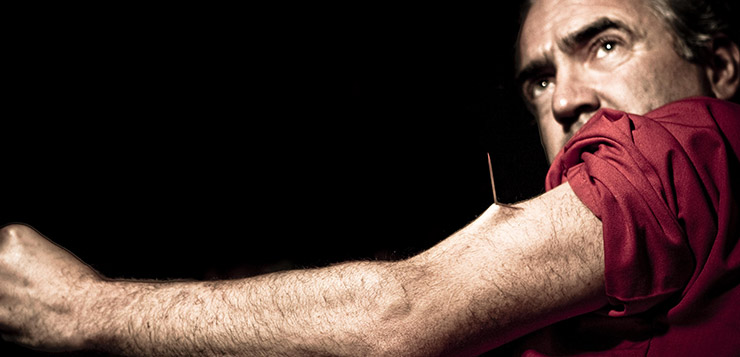He’s a sideshow legend with a talent for deep-tissue skewerings. What can he teach us?
The first time I saw Zamora the Torture King—the stage name of performer Tim Cridland—was at Lollapalooza in 1992. As one of the featured acts in Jim Rose’s Circus Sideshow, he walked barefoot on razors, electrocuted himself to become a human lightbulb, laid down on a bed of nails, and most distressingly, punctured his cheeks and arms with meat skewers and needles. We’re talking deep-tissue punctures.
At the time, despite being pretty thoroughly stoned, I was convinced that the whole thing was fake. It was smoke and mirrors, obviously.
Twenty-plus years later, Zamora is still at it, performing across the world, from nightclubs to fairgrounds—he’s currently on tour in London—and even has his own Guinness World Record, for putting 106 pins into his body at once. He’s written books (Circus of the Scars) and appeared on TV (most recently, Stan Lee’s Superhumans.) But more remarkably than his enduring career, science is starting to take him seriously.
Dr. Joshua Prager, director of the Center for the Rehabilitation of Pain Syndromes at the University of California at Los Angeles, was interviewed by ABC News for a story on Cridland, and admitted that “when I first heard about Tim, I thought more likely he was an illusionist than he was actually doing what he does.” But after examining the skewering stunts up close, he determined that not only were they not illusions, the Torture King isn’t some genetic freak who just doesn’t feel pain.
“He is able to change what he experiences.” Dr. Prager said. “It’s not that the stimuli aren’t there, it’s that the way that he [Cridland] processes them is different than you or I would.”
Could a guy who’s made a living impaling himself five nights a week teach us all something about pain, and how we can better manage it? We decided to find out.
MEN’S HEALTH: This, uh… skill you have. It’s a skill, right?
ZAMORA THE TORTURE KING: Absolutely.
MH: Is it something you’re born with, or do you have to teach yourself how to use your own neck as a shish kabob?
ZAMORA: I learned it. There are people who think like, “Oh, he’s just got a higher pain tolerance.” It wasn’t like that for me. I guess there are some people who are just better at it naturally, but it’s very much a learnable skill.
MH: When did you first learn you could do this?
ZAMORA: Very early on. I was in elementary school, and I would experiment with things, like sewing pins—and put them through the skin of my forearm.
MH: Good lord.
ZAMORA: I’d always been interested in magic tricks and stage illusions, but then I started reading about people in India who could put pins through their bodies. That was much more fascinating, because it was closer to real magic. There weren’t any hidden wires.
MH: You’re mostly self-taught?
ZAMORA: Yes.
MH: I guess that makes sense. It’s not like you can go to your guidance counselor in high school and say, “Hey, can you hook me up with an after-school sideshow?” You have to do all your own homework.
ZAMORA: It’s easier today. You’ve got places like the Coney Island Sideshow School. But when I was growing up, it was very much a lost art. There were a few sideshows kind of floating around. But mostly, I had these old books.
MH: Your teachers never noticed that you were skewering yourself with needles?
ZAMORA: They did eventually. In junior high, everybody had to take a home economics class, which was basically sewing and cooking and things like that. In the middle of the sewing class, I was trying to impress my friend by saying, “Look at this,” and putting these sewing needles through my forearm. And the girls were like, “Oh gross!”
MH: And they told on you?
ZAMORA: They did. The teachers thought it was some kind of self-harming thing. So I convinced them that it was just an illusion, just a magic trick, and I wasn’t really putting the needles in my skin. [Laughs.]
(WARNING: The following video is not for the faint of heart. Watch it at your own risk.)
MH: How long did it take before you could skewer yourself and not feel pain?
ZAMORA: I always feel pain. I’m just able to control it and feel it in a different way.
MH: Explain what that means. How do you feel pain differently?
ZAMORA: I can reduce the way it affects me, what I call the feedback loop of pain. I’m aware of sensations; it’s not like I’m totally numb. If you look on the internet, there are people who claim that I have some type of nerve damage, or my nerves don’t work or something.
MH: And that’s not true?
ZAMORA: Not at all. I’ve basically trained my brain to react differently to the sensation of pain. Which can sometimes be a problem. Pain can be valuable. It’s a warning from the body of danger.
MH: You’ve ignored pain you shouldn’t have ignored?
ZAMORA: I fell off a ladder and hurt my foot, and I dismissed the pain for too long. I was like, “I can work with this.” When I finally got it checked out three weeks later, I found out I’d broken a bone in my foot.
MH: I don’t want to be a stunt show performer, but I’d like to learn how to manage pain better.
ZAMORA: Sure.
MH: Not like ignoring a broken foot for three weeks. But, you know, normal amounts of pain that can be distracting. You don’t want to take aspirin every time you’re a little physically uncomfortable. Do you have any exercises that you do, something that prepares you for handling pain?
ZAMORA: Not really. The main thing is to basically change your relationship with pain. You can visualize pain in different ways, and gain control over it. It’s not to say that you’ll be completely free of pain, but the more you feel trapped by pain, the more it controls you. If you can get out of that feedback loop, you’ll reduce the experience of pain, or at least keep it deep in the background, as opposed to being front and center in the foreground.
MH: Do you distract yourself? I’ve heard about people ignoring pain by going to a happy place in their head. Do you have a happy place?
ZAMORA: I’ve heard about that, too. It’s called attention redirection. Which makes sense in theory, because usually pain wants your full attention. That’s what it does. But I don’t think the key is ignoring it. You’ve got to acknowledge it, and realize what it’s saying to you. Then you can turn your attention elsewhere.
MH: But doesn’t focusing on it give pain more power?
ZAMORA: You don’t focus on it. You just acknowledge it. You…






